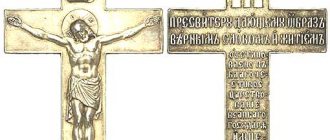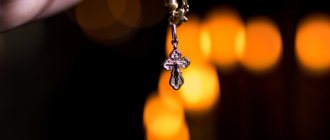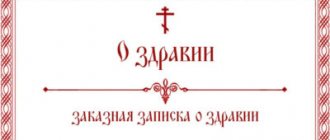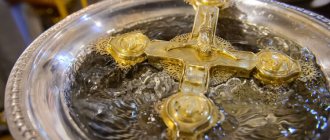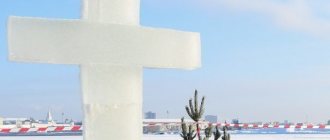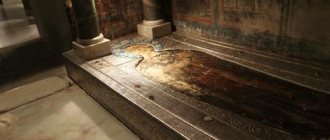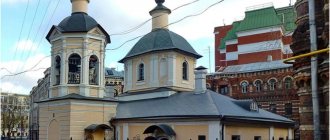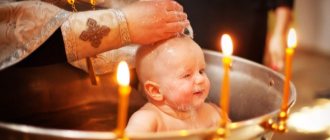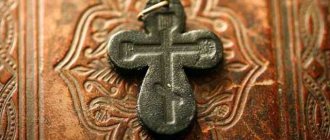The history of the Orthodox cross goes back many centuries. The types of Orthodox crosses are varied, each of them has its own symbolism. Crosses were intended not only to be worn on the body, but they are also used to crown the domes of churches, and crosses stand along the roads. Objects of art are painted with crosses, icon crosses are placed near icons at home, and special crosses are worn by clergy.
Crosses in Orthodoxy
But crosses in Orthodoxy had not only a traditional shape. Many different symbols and forms made up such an object of worship.
How to draw an Orthodox cross with a pencil step by step
The Orthodox cross (Russian cross, or the cross of St. Lazarus) is an eight-pointed Christian cross, the symbol of the Orthodox Church in the eastern Mediterranean, Eastern Europe and Russia. Its peculiarity is the presence of a lower oblique crossbar (foot), in addition to two upper horizontal ones: the upper, smaller one, and the middle, larger one. According to legend, during the crucifixion of Christ, a tablet in three languages (Greek, Latin and Aramaic) with the inscription “Jesus of Nazareth, King of the Jews” was nailed above the cross. A crossbar was nailed under Christ’s feet, but it bent to one side. Thus, two additional crossbars emerged. The crucified Christ himself can be depicted on the cross.
In this manual I will show you how to draw an Orthodox cross with a simple pencil and also suggest drawing an Orthodox cross for beginners, step by step.
We draw an Orthodox cross step by step:
Step one.
Step two.
Step three.
[nextpage] Step four.
Step five.
narisovat.com
The meaning of the image of the spear on the cross of Golgotha
The eight-pointed Orthodox cross on monastic vestments is always accompanied by images of a cane with a sponge and a spear. Those familiar with the text of the Gospel of John well remember the dramatic moment when one of the Roman soldiers named Longinus pierced the Savior’s ribs with this weapon and blood and water flowed from the wound. This episode has various interpretations, but the most common of them is contained in the works of the 4th century Christian theologian and philosopher St. Augustine.
In them he writes that just as the Lord created his bride Eve from the rib of sleeping Adam, so from the wound in the side of Jesus Christ inflicted by the spear of a warrior, his bride the church was created. The blood and water spilled during this, according to St. Augustine, symbolize the holy sacraments - the Eucharist, where wine is transformed into the blood of the Lord, and Baptism, in which a person entering the bosom of the church is immersed in a font of water. The spear with which the wound was inflicted is one of the main relics of Christianity, and it is believed that it is currently kept in Vienna, in the Hofburg Castle.
How to draw a cross with a pencil step by step
Belief in certain higher powers that control our lives with invisible ropes has accompanied man in all eras. It just so happened that a person needs to be sure that the almighty force helps him live and punishes him for mistakes. It stimulates the brain. Only in our time it turns out that there is only one power, but there are hundreds of ways to believe. Let's talk today about
how to draw the life-giving cross.
There was a time when a man was shaggy, but knew that eyes were looking at him from heaven. And a ritual was invented - a sacrifice, which, according to the primitive thoughts of homo sapiens, forced the eyes to close or look in the other direction. And then it started.
They began to give names to such eyes, call them deities and approve of them in every possible way. Over time, these concepts became more civilized, and now we find ourselves in Jerusalem 2000 years ago. Then Jesus Christ lived - a person of great significance in history. It makes no difference whether you believe in his existence or not, but he did a lot of good and kindness, brought a glimmer of light into people's lives. And yet he was crucified on the cross along with the villains and murderers. Here begins the strange story of the cross.
For some reason, the subject of committing a murder, so significant, becomes a symbol of developing Christianity. What if Jesus had been poisoned? Would believers drink rat poison? In this case, the cross is practically a murder weapon. But let's leave the madman in his madness.
At that time, the cross became the main attribute; its image was used in all kinds of scriptures, prayers, and rituals. Here are some interesting moments from the life of the cross:
You can talk here endlessly. But our goal is different, and now we will get down to it.
How to draw a cross with a pencil step by step
Step one.
Step two.
Step three.
Step four.
Step five.
Step six.
For development, see more lessons:
- Learn to draw a star;
- Draw a bow with a pencil;
- Drawing a Christian church;
- Temple drawing lesson;
- The coat of arms of Russia is a double-headed eagle;
TrustNo1
Especially for DayFun
dayfun.ru
Pectoral symbol of the Christian faith
The custom of wearing small crosses made from a variety of materials on the chest appeared only at the beginning of the 4th century. Despite the fact that the main instrument of Christ’s passion was an object of veneration among all his followers literally from the first years of the establishment of the Christian Church on earth, at first it was customary to wear medallions with the image of the Savior on the neck rather than crosses.
There is also evidence that during the period of persecution that took place from the middle of the 1st to the beginning of the 4th century, there were voluntary martyrs who wanted to suffer for Christ and painted the image of the cross on their foreheads. They were recognized by this sign and then given over to torture and death. After the establishment of Christianity as the state religion, wearing crosses became a custom, and during the same period they began to be installed on the roofs of churches.
How to draw a cross entwined with a rose
Let's learn how to draw a beautiful rose wrapped around a cross . I'm sure everyone has tried something similar on their own in class or at home. Now let’s streamline our skills and repeat everything quickly and simply!
We've already drawn a simple flower before and now we'll move on to a real rose .
How to draw a rose and a cross
Step 1.
Let's draw a simple initial shape for the drawing - a small circle in the center for the rose and a cross symmetrical relative to it.
How to draw a rose and a cross step 1
Step 2.
When you start drawing the rose, you will need to start by drawing the swirl of petals in the center. This will form a good template for the beautiful petals of our rose.
How to draw a rose and a cross step 2
Step 3.
Let's continue sketching out the rose petals, which you draw in the center of the cross, you get a nice flower bud. So far our flower is without the main leaves, the leaves themselves and the stem.
How to draw a rose and a cross step 3
Step 4.
Now you will draw a rosebud with fully formed open petals to show that the rose has bloomed.
How to draw a rose and a cross step 4
Step 5.
Let's sketch out the details for the petals with lines.
How to draw a rose and a cross step 5
Step 6.
Let's draw the entire shape of the cross and don't forget to make roundings on the sides and top of the cross. Draw a nice thin line along the inside of the cross for the border. Let's remove all the extra and unnecessary shapes and lines to start drawing the vine and leaves of the rose.
How to draw a rose and a cross step 6
Step 7
This is where you should have a fun time! Let's start drawing the details of the vine and to outline this vine that wraps around the entire body of the cross, we will need a little patience so that it turns out neat and beautiful. Draw all the leaves and thorns then add all the details and leaves.
How to draw a rose and a cross step 7
Step 8
If there are any flaws, remove them before trying to paint. If you succeeded, brag to me)). Good luck with our lessons! Best regards, Nerd!
How to draw a rose and a cross step 8
makusha.ru
Exterior coloring
It is better to shade the front sides of the figure with a ballpoint pen and blue ink. If you do not violate this technique, the picture will turn out more beautiful. Volumetric cross step by step:
If you want to make highlights, use a rubber eraser. The grater can be divided into blue and red, dark white and gray-blue. It is with the darkened side that you need to lightly erase 1 edge of the object, creating light on the figure.
Painting lessons - How to draw a cross with a pencil step by step
| Home » Miscellaneous things Belief in certain higher powers that control our lives with invisible ropes has accompanied man in all eras. It just so happened that a person needs to be sure that the almighty force helps him live and punishes him for mistakes. It stimulates the brain. Only in our time it turns out that there is only one power, but there are hundreds of ways to believe. Let's talk today about how to draw a cross life-giving.
They began to give names to such eyes, call them deities and approve of them in every possible way. Over time, these concepts became more civilized, and now we find ourselves in Jerusalem 2000 years ago. Then Jesus Christ lived - a person of great significance in history. It makes no difference whether you believe in his existence or not, but he did a lot of good and kindness, brought a glimmer of light into people's lives. And yet he was crucified on the cross along with the villains and murderers. Here begins the strange story of the cross. For some reason, the subject of committing a murder, so significant, becomes a symbol of developing Christianity. What if Jesus had been poisoned? Would believers drink rat poison? In this case, the cross is practically a murder weapon. But let's leave the madman in his madness. At that time, the cross became the main attribute; its image was used in all kinds of scriptures, prayers, and rituals. Here are some interesting moments from the life of the cross:
You can talk here endlessly. But our goal is different, and now we will get down to it. How to draw a cross with a pencil step by stepStep one. Step two. Step three. Step four. Step five. Step six.
Source: dayfun.ru Flag material as inappropriate Evaluation of information |
painting-lessons.ru
Two types of body crosses in Ancient Rus'
In Rus', symbols of the Christian faith appeared in 988, simultaneously with its baptism. It is interesting to note that our ancestors inherited two types of pectoral crosses from the Byzantines. It was customary to wear one of them on the chest, under clothes. Such crosses were called vests.
Along with them, the so-called encolpions appeared - also crosses, but somewhat larger in size and worn over clothing. They originate from the tradition of carrying reliquaries with relics, which were decorated with the image of a cross. Over time, encolpions were transformed into the pectoral crosses of priests and metropolitans.
Eight-pointed Orthodox cross: photo, meaning, proportions
The Holy Cross is a symbol of our Lord Jesus Christ. Every true believer, at the sight of him, is involuntarily filled with thoughts about the death throes of the Savior, which he accepted to deliver us from eternal death, which became the lot of people after the fall of Adam and Eve. The eight-pointed Orthodox cross carries a special spiritual and emotional load. Even if there is no image of the crucifixion on it, it always appears to our inner gaze.
An instrument of death that has become a symbol of life
The Christian cross is an image of the instrument of execution to which Jesus Christ was subjected to a forced sentence imposed by the procurator of Judea Pontius Pilate. For the first time, this type of killing of criminals appeared among the ancient Phoenicians and through their colonists, the Carthaginians, it came to the Roman Empire, where it became widespread.
In the pre-Christian period, it was mainly robbers who were sentenced to crucifixion, and then the followers of Jesus Christ accepted this martyrdom. This phenomenon was especially frequent during the reign of Emperor Nero. The very death of the Savior made this instrument of shame and suffering a symbol of the victory of good over evil and the light of eternal life over the darkness of hell.
The eight-pointed cross is a symbol of Orthodoxy
The Christian tradition knows many different designs of the cross, from the most common crosshairs of straight lines to very complex geometric designs, complemented by a variety of symbolism. The religious meaning in them is the same, but the external differences are very significant.
In the countries of the eastern Mediterranean, Eastern Europe, as well as in Russia, since ancient times, the symbol of the church has been the eight-pointed, or, as they often say, the Orthodox cross. In addition, you can hear the expression “cross of St. Lazarus,” this is another name for the eight-pointed Orthodox cross, which will be discussed below. Sometimes an image of the crucified Savior is placed on it.
External features of the Orthodox cross
Its peculiarity lies in the fact that in addition to two horizontal crossbars, of which the lower one is large and the upper one is small, there is also an inclined one, called the foot. It is small in size and located at the bottom of the vertical segment, symbolizing the crossbar on which Christ’s feet rested.
The direction of its inclination is always the same: if you look from the side of the crucified Christ, then the right end will be higher than the left. There is a certain symbolism in this. According to the words of the Savior at the Last Judgment, the righteous will stand on his right hand, and sinners on his left. It is the path of the righteous to the Kingdom of Heaven that is indicated by the raised right end of the footstool, while the left one faces the depths of hell.
According to the Gospel, a board was nailed over the Savior’s head, on which was written by the hand of Pontius Pilate: “Jesus of Nazareth, King of the Jews.” This inscription was made in three languages - Aramaic, Latin and Greek. This is what the small upper crossbar symbolizes. It can be placed either in the interval between the large crossbar and the upper end of the cross, or at its very top. Such an outline makes it possible to reproduce with the greatest reliability the appearance of the instrument of Christ’s suffering. That is why the Orthodox cross has eight points.
About the law of the golden ratio
The eight-pointed Orthodox cross in its classic form is built according to the law of the golden ratio. To make it clear what we are talking about, let us dwell on this concept in a little more detail. It is usually understood as a harmonic proportion, which in one way or another underlies everything that is created by the Creator.
One example of this is the human body. Through simple experiment, we can be convinced that if we divide the value of our height by the distance from the soles to the navel, and then divide the same value by the distance between the navel and the top of the head, the results will be the same and amount to 1.618. The same proportion lies in the size of the phalanges of our fingers. This ratio of quantities, called the golden ratio, can be found literally at every step: from the structure of a sea shell to the shape of an ordinary garden turnip.
The construction of proportions based on the law of the golden ratio is widely used in architecture, as well as other fields of art. Taking this into account, many artists manage to achieve maximum harmony in their works. The same pattern was observed by composers working in the genre of classical music. When writing compositions in the style of rock and jazz, it was abandoned.
The law of constructing an Orthodox cross
The eight-pointed Orthodox cross is also built on the basis of the golden ratio. The meaning of its ends has been explained above; now let us turn to the rules underlying the construction of this main Christian symbol. They were not established artificially, but resulted from the harmony of life itself and received their mathematical justification.
The eight-pointed Orthodox cross, drawn in full accordance with tradition, always fits into a rectangle, the aspect ratio of which corresponds to the golden ratio. Simply put, dividing its height by its width gives us 1.618.
The Cross of Saint Lazarus (as mentioned above, this is another name for the eight-pointed Orthodox cross) in its construction has another feature associated with the proportions of our body. It is well known that the width of a person’s arm span is equal to his height, and a figure with arms spread to the sides fits perfectly into a square. For this reason, the length of the middle crossbar, corresponding to the span of Christ’s arms, is equal to the distance from it to the inclined foot, that is, his height. These seemingly simple rules should be taken into account by every person who is faced with the question of how to draw an eight-pointed Orthodox cross.
Calvary Cross
There is also a special, purely monastic eight-pointed Orthodox cross, a photo of which is presented in the article. It is called the “cross of Golgotha.” This is the outline of the usual Orthodox cross, which was described above, placed above the symbolic image of Mount Golgotha. It is usually presented in the form of steps, under which bones and a skull are placed. To the left and right of the cross a cane with a sponge and a spear can be depicted.
Each of these items has a deep religious meaning. For example, skull and bones. According to Sacred Tradition, the sacrificial blood of the Savior, shed by him on the cross, falling on the top of Golgotha, seeped into its depths, where the remains of our ancestor Adam rested, and washed away the curse of original sin from them. Thus, the image of the skull and bones emphasizes the connection of the sacrifice of Christ with the crime of Adam and Eve, as well as the New Testament with the Old.
The meaning of the image of the spear on the cross of Golgotha
The eight-pointed Orthodox cross on monastic vestments is always accompanied by images of a cane with a sponge and a spear. Those familiar with the text of the Gospel of John well remember the dramatic moment when one of the Roman soldiers named Longinus pierced the Savior’s ribs with this weapon and blood and water flowed from the wound. This episode has various interpretations, but the most common of them is contained in the works of the 4th century Christian theologian and philosopher St. Augustine.
In them he writes that just as the Lord created his bride Eve from the rib of sleeping Adam, so from the wound in the side of Jesus Christ inflicted by the spear of a warrior, his bride the church was created. The blood and water spilled during this, according to St. Augustine, symbolize the holy sacraments - the Eucharist, where wine is transformed into the blood of the Lord, and Baptism, in which a person entering the bosom of the church is immersed in a font of water. The spear with which the wound was inflicted is one of the main relics of Christianity, and it is believed that it is currently kept in Vienna, in the Hofburg Castle.
The meaning of the image of a cane and a sponge
Equally important are the images of the cane and the sponge. From the accounts of the holy evangelists it is known that the crucified Christ was twice offered drink. In the first case, it was wine mixed with myrrh, that is, an intoxicating drink that dulls pain and thereby prolongs the execution.
The second time, having heard the cry “I thirst!” from the cross, they brought him a sponge filled with vinegar and bile. This was, of course, a mockery of the exhausted man and contributed to the approach of the end. In both cases, the executioners used a sponge mounted on a cane, since without its help they could not reach the mouth of the crucified Jesus. Despite such a gloomy role assigned to them, these objects, like the spear, were among the main Christian shrines, and their image can be seen next to the cross of Calvary.
Symbolic inscriptions on the monastic cross
Those who see the monastic eight-pointed Orthodox cross for the first time often have questions related to the inscriptions inscribed on it. Specifically, these are the IC and XC at the ends of the middle bar. These letters stand for nothing more than the abbreviated name – Jesus Christ. In addition, the image of the cross is accompanied by two inscriptions located under the middle crossbar - the Slavic inscription of the words “Son of God” and the Greek NIKA, which means “winner”.
On the small crossbar, symbolizing, as mentioned above, a tablet with an inscription made by Pontius Pilate, the Slavic abbreviation ІНЦІ is usually written, meaning the words “Jesus of Nazareth, King of the Jews,” and above it - “King of Glory.” It became a tradition to write the letter K near the image of a spear, and T near the cane. In addition, from about the 16th century, they began to write the letters ML on the left and RB on the right at the base of the cross. They are also an abbreviation and mean the words “The Place of the Execution is Crucified.”
In addition to the listed inscriptions, it is worth mentioning two letters G, standing to the left and right of the image of Golgotha, and being the initial ones in its name, as well as G and A - Head of Adam, written on the sides of the skull, and the phrase “King of Glory”, crowning the monastic eight-pointed Orthodox cross. The meaning contained in them fully corresponds to the Gospel texts, however, the inscriptions themselves can vary and be replaced by others.
Immortality granted by faith
It is also important to understand why the name of the eight-pointed Orthodox cross is associated with the name of St. Lazarus? The answer to this question can be found on the pages of the Gospel of John, which describes the miracle of his resurrection from the dead, performed by Jesus Christ, on the fourth day after death. The symbolism in this case is quite obvious: just as Lazarus was brought back to life by the faith of his sisters Martha and Mary in the omnipotence of Jesus, so everyone who trusts in the Savior will be delivered from the hands of eternal death.
In the vain earthly life, people are not given the opportunity to see the Son of God with their own eyes, but they are given his religious symbols. One of them is the eight-pointed Orthodox cross, the proportions, general appearance and semantic load of which became the topic of this article. It accompanies a believer throughout his life. From the holy font, where the sacrament of baptism opens the gates of the Church of Christ for him, right up to the gravestone, an eight-pointed Orthodox cross overshadows him.
Pectoral symbol of the Christian faith
The custom of wearing small crosses made from a variety of materials on the chest appeared only at the beginning of the 4th century. Despite the fact that the main instrument of Christ’s passion was an object of veneration among all his followers literally from the first years of the establishment of the Christian Church on earth, at first it was customary to wear medallions with the image of the Savior on the neck rather than crosses.
There is also evidence that during the period of persecution that took place from the middle of the 1st to the beginning of the 4th century, there were voluntary martyrs who wanted to suffer for Christ and painted the image of the cross on their foreheads. They were recognized by this sign and then given over to torture and death. After the establishment of Christianity as the state religion, wearing crosses became a custom, and during the same period they began to be installed on the roofs of churches.
Two types of body crosses in Ancient Rus'
In Rus', symbols of the Christian faith appeared in 988, simultaneously with its baptism. It is interesting to note that our ancestors inherited two types of pectoral crosses from the Byzantines. It was customary to wear one of them on the chest, under clothes. Such crosses were called vests.
Along with them, the so-called encolpions appeared - also crosses, but somewhat larger in size and worn over clothing. They originate from the tradition of carrying reliquaries with relics, which were decorated with the image of a cross. Over time, encolpions were transformed into the pectoral crosses of priests and metropolitans.
The main symbol of humanism and philanthropy
Over the millennium that has passed since the time when the Dnieper banks were illuminated by the light of Christ's faith, the Orthodox tradition has undergone many changes. Only its religious dogmas and basic elements of symbolism remained unshakable, the main one of which is the eight-pointed Orthodox cross.
Gold and silver, copper or made of any other material, it protects a believer, protecting him from the forces of evil - visible and invisible. As a reminder of the sacrifice made by Christ to save people, the cross has become a symbol of the highest humanism and love for one's neighbor.
fb.ru
An instrument of death that has become a symbol of life
The Christian cross is an image of the instrument of execution to which Jesus Christ was subjected to a forced sentence imposed by the procurator of Judea Pontius Pilate. For the first time, this type of killing of criminals appeared among the ancient Phoenicians and through their colonists, the Carthaginians, it came to the Roman Empire, where it became widespread.
In the pre-Christian period, it was mainly robbers who were sentenced to crucifixion, and then the followers of Jesus Christ accepted this martyrdom. This phenomenon was especially frequent during the reign of Emperor Nero. The very death of the Savior made this instrument of shame and suffering a symbol of the victory of good over evil and the light of eternal life over the darkness of hell.
Arrangement of the grave according to Orthodox canons
The cemetery cross must always be present at the grave of the deceased. But it is permissible to choose any of the options:
- standing separately;
- combined with a tombstone;
- in the form of an engraving on the monument.
Engraving on a monument is too weak a symbol of belief; this method is usually used by the relatives of a deceased suicide in order to bring the deceased at least a little closer to the shrine. To arrange the grave of a believer, it is better to choose a free-standing cross or combined with a tombstone.
Religious attributes are placed on the grave immediately after burial. For this, a wooden product is used, since it is distinguished by its low weight - the object will not press through loose soil. But it is customary to change it to a more reliable option, only later. They put up a large, heavy tombstone. Due to this, the product looks monumental.
It is recommended to replace it no earlier than after 1 year. This is the most correct option, because by that time the soil will be completely compacted, and the condition of the cemetery plot can be assessed. If you dismantle the wooden cross earlier and then start installing a heavy tombstone, the soil will quickly subside and the monument will sag. At the same time, they are considering the option of installing a flower bed, a table, or a table. It is important to fence the area with a low fence.
Table: materials for making a cross, pros and cons
Design and shape are not the only parameters that are paid attention to. It is necessary to take into account the properties of the product, which means determining the appropriate type of material. To do this, it is recommended to carry out a simple data analysis:
| Type of material | Advantages | Flaws |
| Tree | light weight; attractive structure of the material - natural pattern formed by fibers; ease of manufacture and installation. | exposure to water; short service life; low resistance to insects and microorganisms. |
| Metal | high strength; resistance to external factors; average service life. | the need for processing to avoid rusting; expensive equipment is required; experience is needed to perform welding work. |
| Stone | high strength; attractive appearance; reliability, long service life; the ability to create complex compositions, statues, monuments. | difficulty in processing in the absence of experience; some types of stone (marble) are susceptible to moisture; heavy weight, it is impossible to carry the product yourself. |
Various materials have a number of operating features and properties that affect the quality of processing and application.
Before making a choice, you need to compare different types of wood, metal and stone.
Wooden cross
A crucifix is made in the simplest form. This is due to the fact that even those who have not had such experience can work with the material. But it is possible to make more complex ritual attributes - carved ones. They can have different shapes, which are given using tools for carving and firing.
Wooden crosses
Types of wood
Considering that natural material is susceptible to moisture, it is necessary to increase its service life by all means. For this purpose, wood with special properties is selected. Some breeds are more resistant to water:
- oak;
- beech;
- larch;
- pine;
- teak;
- Iroko.
The most affordable option is coniferous wood. Teak and iroko are elite varieties of wood. Oak is a middle option between the above and is highly durable. Larch can remain in water for a long time without changing shape or losing properties.
How to protect the cross
You can further improve the characteristics of a wooden cross. For this, various compositions are used:
- antiseptic;
- hydrophobic;
- primers;
- paint and varnish.
It is necessary to protect the tree from the effects of fungi, mold, and microorganisms. Antiseptic liquids are used for this. Hydrophobic materials increase the wood's resistance to water. The primer improves the quality of the finishing coat due to improved adhesion.
Paint and varnish materials make the structure attractive and also further increase resistance to moisture, but they require constant updating.
Metal cross
In terms of external qualities it is inferior to most types: wooden, stone. But some types of metal structures still have decent characteristics. But, regardless of the type, the material requires strong fastening - the welding method is used.
Metal cross on the grave
Welded
Individual elements are made: from profile pipes, corners, sheet metal. First, a cross is created, then decorative elements are added. This option has disadvantages:
- high risk of metal rusting in areas where welds are located;
- low level of attractiveness, even after cleaning the seams, unevenness remains, traces of joining parts are visible.
Forged
Made from metal, the result is a cross with excellent external properties. This is due to the use of forged structural elements. This crucifix has a high level of strength. But forging is often combined with welding.
Stone cross
If you need to preserve the appearance of the deceased over the centuries, you should definitely choose a stone for making a tombstone. But the properties of different types of materials differ, some last longer than others, and are more attractive.
Stone structures are difficult to make with your own hands if you don’t have experience. In this case, you need to be able to work with a special tool, an array of materials.
Orthodox stone cross on the grave
Granite
Natural stone, like its synthetic counterpart (porcelain stoneware), is characterized by a high level of strength. Due to this, it is possible to preserve the product for centuries. There are different types of it: with green, brown, red, gray and black undertones. Images and inscriptions, like polishing, will be preserved for a long time. In addition, the material is completely moisture resistant.
Marble
Almost as durable as granite, but still slightly more susceptible to mechanical stress. Marble is also inferior in some other parameters: moisture resistance, acid resistance. But products made from such material are attractive, and there are options in different shades.

